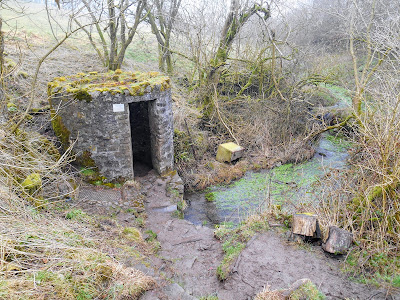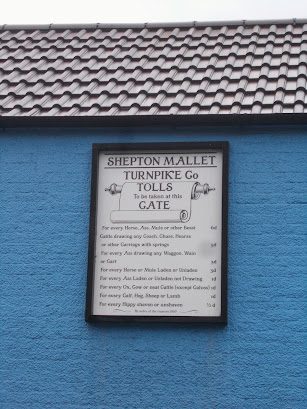By the mid 16th century it was recognised that most roads in England were in a very poor state of repair and that many of them were impassable in winter. An Act of Parliament was passed in 1555, which attempted to address the problem by placing responsibility for road repair in the hands of parishes. Each parish was required to elect two surveyors. Their job was to oversee the repair of roads in their parish. The labour was provided by the residents of the parish, who were required to spend four days a year each repairing the roads. In 1562 another act was passed, which increased the number of days per resident to six per year, with fines for those did not comply. However much of the damage to roads was caused by traffic passing through, rather than by local residents.
Local Justices of the Peace were given the powers by Parliament to erect toll gates on part of the Great North Road (now the A1) in 1663. Twelve more Justice Trusts were set up between 1696 and 1714 on sections of road, which were particularly badly maintained. Local groups of wealthy people paid for improved roads to be built and then charged people tolls for using them.
The first turnpike trusts were set up in 1707 and were run by trustees, who were local Justices, gentlemen and landowners. The trusts were non-profit making. 133 were set up by Acts of Parliament before 1750. They were given powers to levy tolls on the users of specified stretches of road, usually about 20 miles in length. Between 1751 and 1772 another 418 acts were passed and the turnpike network expanded across the whole of England, although only about a fifth of Britain's roads were turnpikes. The last act was passed in 1836, by which time the railway network was beginning to be developed.
Turnpikes trusts erected gates across their roads at strategic locations to collect tolls from the people who used them. Early turnpikes had wooden gates but those built in the 19th century often had gates made of wrought iron. The gates were often at points where it was least likely that horse riders or horse drawn vehicles could avoid paying the toll e.g. bridges and crossroads. They were usually located outside urban areas to avoid charging local businesses.
The word turnpike was originally a military term for "a spiked barrier fixed in or across a road or passage, as a defence against sudden attack, especially of men on horseback." (Oxford English Dictionary). The bars erected on toll roads resembled these barriers and so they were referred to as turnpikes from the late 17th century.
In some cases existing cottages were adapted to house toll collectors (or pikemen as they were sometimes known) and their families. Sometimes temporary shelters were built for the toll collectors. Later on most toll houses were purpose built. Early toll houses were built in the same style as local cottages in the area but by the 19th century a distinctive style evolved. Many toll houses resembled the lodges built at the entrance to large estates and those built in the 1820s had polygonal fronts, which gave the toll collectors good views up and down the roads. Toll houses were usually built close to the road and many of them had porches, which jutted out into the road. On major roads grander toll houses were built e.g. with castellations on them to impress wealthy travellers. The isolated location of most toll houses meant that they were vulnerable to attack by thieves and highwaymen. Therefore the windows often had shutters and/or bars on them and the houses also had built-in safes. Toll houses were often built to a higher standard that most of the local vernacular cottages, in order to attract honest and reliable toll collectors.
The turnpike road network reached its greatest extent in the 1840s when there were over 20,000 miles of roads controlled by over 1,000 trusts. Traffic on the turnpike roads declined from the 1840s as the railway network developed. Most turnpike trusts were wound up in the 1870s and the toll houses were sold off. Some became commercial buildings such as pubs and post offices but most became residential dwellings. The last turnpike trust to be wound up was one on Anglesey in 1895. Responsibility for the roads was taken over by Highway Boards and later County Councils.

Toll House, Nether Stowey
Toll House, Snowdon Hill, A30, Chard
Horsington Toll House
Horsington Toll Board
Stanton Drew Toll House
Worthy Toll Road Toll House, Porlock Weir - still in use as a toll house
Toll House, Glaston Road, Street
You can see where the original doorway facing the road has been blocked up at some point.
Toll House, Glaston Road, Street
Toll House at Shipham
Red Post Toll House on the A367 at Peasedown St John
This house on Silver Street in Taunton was probably once a toll house
Exebridge Toll House on A396 at the Devon/Somerset border
Toll Cottage, Tower Hill, A358, Williton
Sidcot Gate Toll House on the A38 at Sidcot
Blue plaque on the Sidcot Gate Toll House
Old Down Toll House
This was built in 1835 and is located on the B3139 (Lynch Hill), opposite the junction with Coalpit Lane.
Hartlake Turnpike plaque at the junction of the A39 with Chasey's Drove, to the north of Glastonbury. This was part of the Wells Turnpike Trust.
Terminus stone on the Brendon Hills at Elworthy, marking the western boundary of the Taunton Turnpike Trust
The Taunton Turnpike Trust was in operation from 1752 until 1875.
Part of the toll board from Misterton Gate
This is now on display in the Museum of Somerset in Taunton.
East Cranmore Toll House on the A361
Charlton Toll House on the A361 at Shepton Mallet
Toll Cottage, on the corner of Ford Road (B3188) and Taunton Road (B3227) in Wiveliscombe
Toll house, 48 Chilkwell Street, Glastonbury
Modern toll board on the toll house, 48 Chilkwell Street, Glastonbury
Further Reading:
The Toll-houses of Somerset by Jane Dowding and Patrick Taylor. Published by Polystar Press, 2013
































